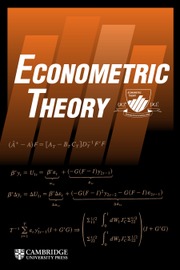No CrossRef data available.
Article contents
SWITCHING REGIME INTEGER AUTOREGRESSIONS
Published online by Cambridge University Press: 17 October 2025
Abstract
Time series of counts often display complex dynamic and distributional characteristics. For this reason, we develop a flexible framework combining the integer-valued autoregressive (INAR) model with a latent Markov structure, leading to the hidden Markov model-INAR (HMM-INAR). First, we illustrate conditions for the existence of an ergodic and stationary solution and derive closed-form expressions for the autocorrelation function and its components. Second, we show consistency and asymptotic normality of the conditional maximum likelihood estimator. Third, we derive an efficient expectation–maximization algorithm with steps available in closed form which allows for fast computation of the estimator. Fourth, we provide an empirical illustration and estimate the HMM-INAR on the number of trades of the Standard & Poor’s Depositary Receipts S&P 500 Exchange-Traded Fund Trust. The combination of the latent HMM structure with a simple INAR $(1)$ formulation not only provides better fit compared to alternative specifications for count data, but it also preserves the economic interpretation of the results.
$(1)$ formulation not only provides better fit compared to alternative specifications for count data, but it also preserves the economic interpretation of the results.
Information
- Type
- ARTICLES
- Information
- Creative Commons
- This is an Open Access article, distributed under the terms of the Creative Commons Attribution-NonCommercial-NoDerivatives licence (https://creativecommons.org/licenses/by-nc-nd/4.0), which permits non-commercial re-use, distribution, and reproduction in any medium, provided that no alterations are made and the original article is properly cited. The written permission of Cambridge University Press must be obtained prior to any commercial use and/or adaptation of the article.
- Copyright
- © The Author(s), 2025. Published by Cambridge University Press
Footnotes
We are grateful to the Editor, Prof. Yixiao Sun, and two anonymous reviewers for their extremely useful remarks that greatly improved the quality of the current version of the manuscript. We are also grateful to Kim Christensen for providing us with the high-frequency data on the number of trades and trading volume used in the empirical analysis. We also thank the participants at the HFFE workshop in Pisa (September 2018), the HAX conference in Xiamen (October 2018), the ICEEE conference in Lecce (January 2019), the NBER-NSF Time series conference in Hong Kong (August 2019), the Econometrics in the Arena workshop in Verona (September 2019), the IWEEE Time Series conference in Venezia (January 2020), the SNDE Symposium in Padua (March 2024), the SofiE conference in Rio de Janeiro (June 2024), and the workshop in honor of Carlo Giannini in Pavia (September 2024) for useful comments and suggestions. L.C. and P.S.d.M. acknowledge the research support of the Project 2 grants of the Danish Council for Independent Research (IRFD), Social Sciences, number 8019-00015A and 3099-00089B, and of the Aarhus Universitets Forskningsfond (AUFF). P.S.d.M and E.R. acknowledge the research support of the European Union's - Next Generation EU program through the Italian PRIN 2022 - M4C2, Investment 1.1 - “Monitoring Risks in Financial Markets” – Codice Cineca: 2022NEL482 - CUP: I53D23003410008.

